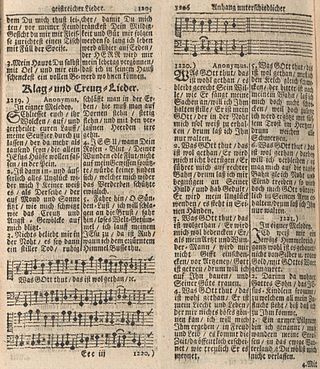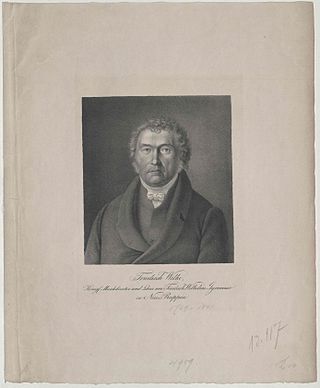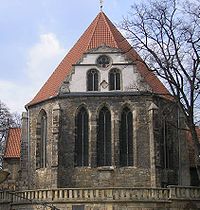Karl Richter was a German conductor, choirmaster, organist, and harpsichordist.

Arnstadt is a town in Ilm-Kreis, Thuringia, Germany, on the river Gera about 20 kilometres (12 mi) south of Erfurt, the capital of Thuringia. Arnstadt is one of the oldest towns in Thuringia, and has a well-preserved historic centre with a partially preserved town wall. The town is nicknamed Das Tor zum Thüringer Wald because of its location on the northern edge of that forest. Arnstadt has a population of approximately 27,000.
The Neumeister Collection is a compilation of 82 chorale preludes found in a manuscript copy produced by Johann Gottfried Neumeister (1757–1840). When the manuscript was rediscovered at Yale University in the 1980s it appeared to contain 31 previously unknown early chorale settings by Johann Sebastian Bach, which were added to the BWV catalogue as Nos. 1090–1120, and published in 1985.

Sechs Chorale von verschiedener Art: auf einer Orgel mit 2 Clavieren und Pedal vorzuspielen, commonly known as the Schübler Chorales, BWV 645–650, is a set of chorale preludes composed by Johann Sebastian Bach. Johann Georg Schübler, after whom the collection came to be named, published it in 1747 or before August 1748, in Zella St. Blasii. At least five preludes of the compilation are transcribed from movements in Bach's church cantatas, mostly chorale cantatas he had composed around two decades earlier.

Harald Vogel is a German organist, organologist, and author. He is a leading expert on Renaissance and Baroque keyboard music. He has been professor of organ at the University of the Arts Bremen since 1994.
Käte van Tricht, was a German organist, pianist, harpsichordist, and pedagogue.
Johann Caspar Vogler was a German organist and composer taught by Johann Sebastian Bach.

Wo Gott der Herr nicht bei uns hält is a chorale fantasia for organ composed by Johann Sebastian Bach in the early 18th century, likely between 1705 and 1710. The Zahn 4441a hymn tune for Justus Jonas's 1524 hymn "Wo Gott der Herr nicht bei uns hält", a paraphrase of Psalm 124, is the basis of the composition.

Divi Blasii is a Gothic church in the Thuringian town of Mühlhausen, central Germany. Besides St Mary's, it is one of Mühlhausen's two principal churches. Divi Blasii is a three-aisle, cruciform hall church, situated on the Untermarkt in the historical centre of the town. The elaborately designed display façade with tracery, pinnacles and a wheel window on the north side is located on an old trade route. Today, Divi Blasii is the central parish church of the Lutheran parish of Mühlhausen within the Protestant Church in Central Germany.
Johann Friedrich Wender was a German organ builder who had his workshop in Mühlhausen.

Johann Sebastian Bach's Prelude and Fugue in C major, BWV 531, is a prelude and fugue in C major, written for the organ c. 1707.

"Was Gott tut, das ist wohlgetan" is a Lutheran hymn written by the pietist German poet and schoolmaster Samuel Rodigast in 1675. The melody has been attributed to the cantor Severus Gastorius. An earlier hymn with the same title was written in the first half of the seventeenth century by the theologian Michael Altenburg.

"An Wasserflüssen Babylon" is a Lutheran hymn by Wolfgang Dachstein, which was first published in Strasbourg in 1525. The text of the hymn is a paraphrase of Psalm 137. Its singing tune, which is the best known part of the hymn and Dachstein's best known melody, was popularised as the chorale tune of Paul Gerhardt's 17th-century Passion hymn "Ein Lämmlein geht und trägt die Schuld". With this hymn text, Dachstein's tune is included in the Protestant hymnal Evangelisches Gesangbuch.
Winfried Schrammek was a German musicologist and organist.

Herbert Collum was a German organist, harpsichordist, composer and conductor.

Wolfgang Baumgratz is a German organist and academic teacher. He is the organist of the Bremer Dom, and professor of organ at the Hochschule für Künste Bremen. He has toured in Europe as a concert organist and made recordings. He was president of the international association Gesellschaft der Orgelfreunde from 1998 to 2013.

Christian Friedrich Gottlob Wilke was a German organist, composer, music teacher, music writer and organ revisor.
Hans Heintze was a German Kantor and organist.
Hans Otto was a German organist, harpsichordist and cantor.

Johann Gottfried Olearius (1635–1711) was a German preacher, musician and horticulturalist. Johann Gottfried was a member of a large, extended family of pastors, theologians, professors and lawyers in Halle, Leipzig and Weissenfels. He was the superintendent and pastor of the Barfüsserkirche. He had been an accomplished church musician and supervised the young Johann Sebastian Bach when he was a church organist at Arnstadt from 1703 to 1707. Olearius also had an interest in horticulture, and the plant genus Olearia was named in his honour by Conrad Moench.















